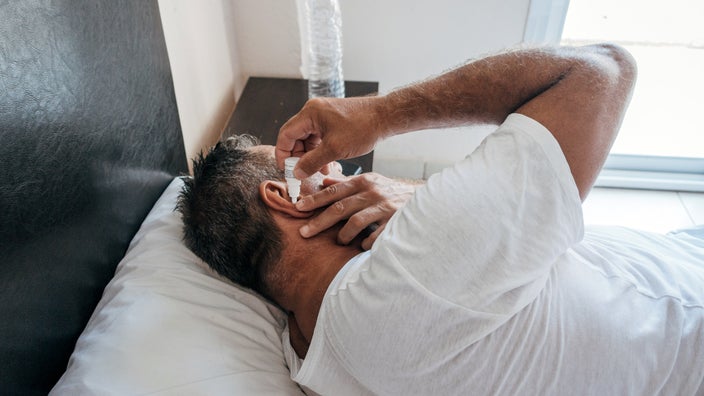
How to Safely Remove Ear Wax Blockage at Home
Key takeaways:
-
Earwax is naturally made by the body to protect the ears. But too much earwax can lead to hearing changes and discomfort.
-
Safe home remedies for earwax removal include ear drops and irrigation. Don’t use instruments or objects to remove earwax.
-
If you have ear pain, drainage, or hearing loss, see a healthcare provider.

If you’ve ever had uncomfortable ear fullness or dulled hearing, then you’re probably already familiar with cerumen impaction — or, to put it simply, an earwax blockage.
Too much earwax can lead to an annoying blockage. If you’re prone to earwax blockages, then you probably are looking for some ways to easily remove earwax at home.
There are easy and safe ways you can remove any extra earwax. But there are also some options you want to avoid. Let’s take a look at home remedies that can help you safely remove earwax.
Search and compare options
What is earwax?
Earwax, also known as cerumen, is a substance that the body naturally makes on a regular basis.
Skin cells inside the ear are constantly turning over to provide new, fresh skin. But, unlike skin on other parts of the body, the ear canal provides little room for dead cells to go. So, to prevent dead skin cells from clogging up the ear, glands inside the ear make oily substance to help trap dead skin cells. This creates earwax.
Earwax is actually very helpful, as it helps moisturize the ears. It also protects the ears by blocking bacteria, fungus, and other substances from entering the inner parts of the ear.
In most cases, ear wax doesn’t need to be removed. Experts at the American Academy of Otolaryngology-Head and Neck Surgery recommend that people don’t try to remove earwax that’s not causing any symptoms. Earwax is protective, and continuing to remove it can possibly lead to more problems, such as infection. This can even increase the risk of a clogged ear in the future.
But when wax starts to pile up, it can be a problem. Too much wax can lead to discomfort, temporary hearing loss, and sometimes even an ear infection.
-
Need help finding the right ear wax drops? Here’s 6 over the counter options that can free you from earwax.
-
Wondering why you have so much earwax build up? Learn about the most common causes of earwax buildup.
-
Are your ears ringing? It could be earwax but here’s other reasons your ears could be ringing.
What causes an earwax blockage?
Normally earwax moves out of the ear when people move their jaw. This happens a little at a time so you don’t usually notice it.
But sometimes this doesn’t work the way it should and wax sits in the ear too long, becoming dry and hard. This leads to stuck earwax — also called an earwax impaction. This is more common in people who wear hearing aids. Hearing aids can block movement of wax out of the ear. Children and older adults are at higher risk for developing earwax impactions. But it can happen to anyone.
Stuck earwax can cause symptoms like:
-
Muffled hearing
-
Ear fullness or discomfort
-
Ear itching
Read more like this
Explore these related articles, suggested for readers like you.



What are some home remedies that help remove earwax?
If you’re prone to earwax impactions, you probably want a few tips to remove earwax quickly and easily at home. There are some safe and effective ways to do this at home.
At-home earwax treatments include ear drops, sprays, or irrigation solutions.
Ear drops or irrigation should never cause pain. If you try these earwax removal home remedies and experience pain, contact your healthcare provider immediately.
Ear irrigation
Irrigation with warm saline or sterile water can be a good first step toward at-home earwax removal. Here’s how you do it:
-
Fill a small (5 mL to 10 mL) syringe full of saline or sterile water. Always use sterile water, never use tap water as it can increase the risk for serious infections. You want the liquid to be room or body temperature. Putting liquid that’s cool or cold into your ear can lead to unpleasant side effects like nausea, dizziness, and vertigo.
-
While keeping your head upright and a towel or bin under your ear, slowly squirt the fluid upwards toward the wax collection. Try not to squirt the water directly at your eardrum, as this may damage the eardrum. Also avoid irrigating too fast, as this can cause ear pain, or even bleeding.
-
Tilt your head sideways to remove the water or saline.
Earwax softeners
Sometimes, the earwax needs to be softened a little with earwax removal drops or sprays. These can be used alone or with irrigation for earwax removal at home. Once the earwax is softened, the body can often remove the wax on its own, no irrigation needed.
Earwax softeners are available over the counter or you can make your own. Popular options include:
-
Carbamide peroxide: Carbamide peroxide drops are available over the counter. You can place 5 to 10 drops in the affected ear twice per day for up to 7 days.
-
Baking soda solution: A baking soda solution can also help soften wax. You can make it on your own using 1 part sterile water and 1 part baking soda. Fill a small syringe with the solution and place 5 drops in your ear once a day.
-
Hydrogen peroxide 3% solution: You can buy this solution at any drugstore. To soften wax, fill a small syringe with the solution and place 5 to 10 drops in your ear canal 15 to 30 minutes before irrigating.
-
Mineral or baby oil: These are available over the counter. Experts recommend placing 3 drops into the affected ear at bedtime for 3 or 4 days. Other oils like olive oil and camphor oil also appear to be safe to use. Or you can try products containing arachis oil (peanut oil) or almond oil, as long as you do not have a nut allergy.
-
Liquid docusate sodium: Docusate sodium is a medication that’s meant for constipation, but it can also be used to help soften earwax. Experts recommend putting 1 mL into the affected ear 15 minutes before irrigation.
What options aren’t safe to use for at-home earwax removal?
Next let’s look at home remedies for earwax removal that are best to avoid.
Cotton swabs
It may be tempting, but don’t try to dig out your earwax using cotton tipped swabs (like Q-Tips). Many people injure or rupture their eardrums trying to dig out their earwax.
Plus these items can push earwax deeper into your ear canal making it harder to get out. And deeper earwax is also more likely to touch your eardrum and cause hearing changes and pain.
Hair pins or paper clips
Healthcare providers sometimes caution patients, “Don’t put anything smaller than your elbow in your ear!” In addition to driving wax deeper into the ear, objects like hair pins or paper clips can damage the skin lining the ear canal and bring in harmful bacteria. That may lead to an infection of the outer ear, called otitis externa.
Ear candles
Ear candles are long, hollow candles that are inserted into the ear canal. The end sticking out of the ear is then lit. As you might imagine, people using ear candles can burn themselves. And ear candles may plug the ear with candle wax or rupture the eardrum.
When should you see a healthcare provider for earwax removal?
Not everyone should try to remove their earwax at home. You should see a healthcare provider before trying to remove wax if you have had trauma to the ear or any of these symptoms:
-
Fever
-
Ear drainage
-
Severe ear pain
-
Hearing loss
-
Ear ringing
These can be symptoms of an outer ear infection or inner ear infection.
People with medical conditions that increase their risk for bleeding or infection should see a healthcare provider for earwax removal. These conditions include:
-
Bleeding disorders like hemophilia
-
Liver disease
-
Low platelet counts
-
Weakened immune systems
-
A history of ear surgery
People who take blood thinners like coumadin, clopidogrel, or novel anticoagulants like rivaroxaban should also see a healthcare provider for earwax removal.
Experts also advise against at-home earwax removal in young children.
Can you prevent earwax from building up over time?
Yes. One of the best things you can do to prevent earwax buildup is to avoid overcleaning. In this case, you may have a higher risk of a clogged ear in the future. So unless that earwax is really bothering you, leave it be and let your body remove it naturally.
And most importantly, avoid putting any objects into the ear, including cotton swabs, hair pins, or ear candles. These can not only damage the ear, but they can also worsen the problem by pushing more wax deeper into the canal.
The bottom line
Earwax is a natural way the body protects the eardrum from viruses, bacteria, and other toxins in the environment. Yet sometimes, too much can build up and become a problem. Usually, softening the wax and irrigating the ear at home will get extra wax out. But, don’t hesitate to see your healthcare provider when you have any concerning symptoms, such as pain, drainage, or hearing loss.
Why trust our experts?



References
Aaron, K., et al. (2018). Ear drops for the removal of ear wax. Cochrane Database of Systematic Reviews.
Dean, L. (2006). Don’t put anything smaller than your elbow in your ear. Coffee Break: Tutorials for NCBI Tools.
ENT Health. (n.d.). Are ear candles a safe option for removing earwax? American Academy of Otolaryngology–Head and Neck Surgery.
Michaudet, C., et al. (2018). Cerumen impaction: Diagnosis and management. American Family Physician.
Munakomi, S., et al. (2023). Caloric reflex test. StatPearls.
National Health Services. (2024). Earwax build-up.
National Institute for Health and Care Excellence. (2018). Management of earwax. Hearing Loss in Adults: Assessment and Management.
Ponen, S. (2022). Cerumol. Healthify.
Rafferty, J., et al. (2007). Ear candling. Canadian Family Physician.
Schumann, J. A., et al. (2022). Ear irrigation. StatPearls.
Schwartz, S. R., et al. (2017). Clinical practice guideline (update): Earwax (cerumen impaction) executive summary. Otolaryngology–Head and Neck Surgery.
Wright, T. (2015). Ear wax. British Medical Journal Clinical Evidence.




